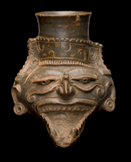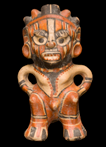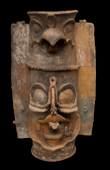Source http://popular-archaeology.com/issue/09012013/article/rarely-seen-mesoamerican-artifacts-revealed

Lempa River vessel depicting the god of fire, AD 900–1200 - San Salvador Department, El Salvador - Pottery, clay slip -Gift of Theodore T. Foley, 1972 (24/7225). Photo by Ernest Amoroso, Smithsonian’s National Museum of the American Indian
Few people know that the Smithsonian Institution curates one of the largest single collections of whole Mesoamerican ceramic artifacts in the world -- more than 12,000, to be specific. But most of these objects are tucked away unseen by most people within the storage "vaults" that house all of the other massive museum collections, the largest in the world.

Pre-Classic period Maya human-monkey figure, AD 200–300 - Villa de Zaragoza, Chimaltenango Department, Guatemala - Pottery - Purchased for MAI by staff member Marshall H. Saville, 1920 (9/8479).- Photo by Ernest Amoroso, Smithsonian’s National Museum of the American Indian
Now, after more than two years of research on the museum’s Central American ceramics collections under the sponsorship of the Smithsonian"s Latino Center, curator Ann McMullen and guest curator Alexander Villa Benitez of George Mason University have selected more than 160 objects from the museum’s vast collection of ancient ceramics from the region, and augmented it with other significant examples of work in gold, jade, copper, marble, shell and stone. The objects represent a rich variety of Central American cultures spanning the period from 1000 B.C. to the present, illustrating the complexity of Mesoamerican civilization in terms of social and trade networks, technology, artwork and systems of status and political organization. Under the rubric, Cerámica de los Ancestros: Central America's Past Revealed, they are now shared in a public exhibition that examines seven regions representing distinct Central American cultural areas that are today part of Belize, Costa Rica, El Salvador, Guatemala, Honduras, Nicaragua and Panama.

Greater Nicoya female figure, AD 800–1350 - Near Rivas, Rivas Department, Nicaragua - Pottery, clay slip, paint - Collected about 1920 by Raul R. Barrios, acquired by MAI in 1928 (15/9362). Photo by Ernest Amoroso, Smithsonian’s National Museum of the American Indian
“This is our first major exhibition that examines our remarkable Central American collection, which is world class based on its sheer size and the fact that these are whole and intact objects,” said Kevin Gover (Pawnee), director of the Smithsonian’s National Museum of the American Indian. “It also marks the first time that we have created a bilingual exhibition that will increase our scholarship and outreach to an entirely new audience.”

Classic period Maya incense burner depicting the rain god, AD 250–900 - Near San Ignacio (Cayo), Cayo District, Belize - Pottery, paint - MAI purchase from Dr. Thomas W.F. Gann, 1918 (9/1819). Photo by Ernest Amoroso, Smithsonian’s National Museum of the American Indian
The exhibition is accompanied by an interactive website that includes 3-D images of select objects and a landmark publication, Revealing Ancestral Central America, edited by Rosemary A. Joyce.
The exhibition will be open through Feb. 1, 2015, in the third level W. Richard West Jr. Contemporary Arts Gallery at the National Museum of the American Indian in Washington, D.C.